塑料污染、气候变暖、臭氧损耗和海洋酸化是当前亟需关注的全球重要环境问题[1]。塑料制品的大量使用和无序处置使得每年约有1 000万t塑料进入海洋,预计到2050年全球的海洋塑料垃圾将会超过海洋中鱼类的数量[2]。一般定义粒径或大小<5 mm的塑料为微塑料[3]。环境中微塑料的来源分为2类:一类由海洋塑料经波浪、风化和降解等作用的分解产生;另一类是目的性生产的塑料微球和洗衣废水中的纤维等[4-5]。微塑料本身含有壬基酚和溴化阻燃剂等内分泌干扰物和致癌物[6-7],同时由于其高比表面积和疏水性,微塑料易吸附重金属、多环芳烃、多氯联苯和双酚A等污染物,且微塑料-污染物复合体可被海洋生物误食,导致海洋生物的肠道堵塞和病理损害的双重毒性作用[7-10]。随后,微塑料及其吸附的污染物能够通过食物链富集,最终危害人体健康[11-13]。
因微塑料具有比表面积大、难降解和较强的吸附能力等特性,其可作为微生物的保护性和营养性载体,给微生物提供稳定的栖居环境和丰富的营养底质[14-15]。微生物能在微塑料表面迅速寄居并大量生长繁殖,形成一个由异养菌、自养菌和共生体等组成的多样化微生物群落,称之为“plastisphere”(塑料圈)[14]。近年,越来越多的研究表明生物膜与微塑料的互作对海洋环境的影响不容小觑。微塑料作为一种独特的生态位点,可以改变微生物群落结构,影响微生物功能(如对碳和氮的获取和循环)[16-17]。同时由于微塑料的保护和载体作用,其表面附着的微生物群落及吸附的污染物在海洋中的稳定性得以增强,并易造成更加严重的潜在生态风险[15,18]。另外,微塑料生物膜上极易寄居一些致病菌落。例如,Viršek等[19]首次从暴露于北亚得里亚海的微塑料上鉴定出致病性鱼类细菌杀鲑气单胞菌;Wu等[20]在微塑料圈中检测到2种潜在人类病原体(Pseudomonas monteilii和Pseudomonas mendocina)和一种植物病原体(Pseudomonas syringae),而在自然基质上形成的生物膜中未检测到致病菌。
生物膜的形成能够显著改变微塑料的理化特性,进而影响其环境归趋。例如,生物膜的形成改变了微塑料的表面官能团和疏水性能,进而增强其对水环境中痕量金属、有机污染物的吸附能力[21-22]。同时附膜后的微塑料,其外观、气味和味道都更像食物,更易被海洋动物摄食[23]。近年来,微塑料逐渐成为环境领域的热点话题,相关研究成果也不断产出和丰富。目前关于微塑料的综述主要侧重于其本身在环境中的赋存特征、生态毒性和环境行为方面,并未对影响其在环境中迁移和归趋的环境因素进行系统归纳[24]。因此,本文从微生物的角度,综述了海洋环境中微生物的定殖对微塑料微观形貌、晶体结构、密度和疏水性等理化性质的影响,并进一步讨论了生物膜的形成对其沉降、吸附等环境行为的影响及其机理,对科学地评价微塑料的长期环境效应、预测微塑料的生态风险具有重要意义。
1 生物膜的形成对微塑料理化性质影响(Effects of biofilm formation on physicochemical properties of microplastics)
随着微生物的定殖,微塑料的理化性质逐渐发生改变,主要表现在其密度增大、粒径减小、疏水性降低、粗糙度增大、结晶度降低、微观形貌及表面电荷发生变化等[25-28]。测定微塑料理化性质的方法如图1所示。
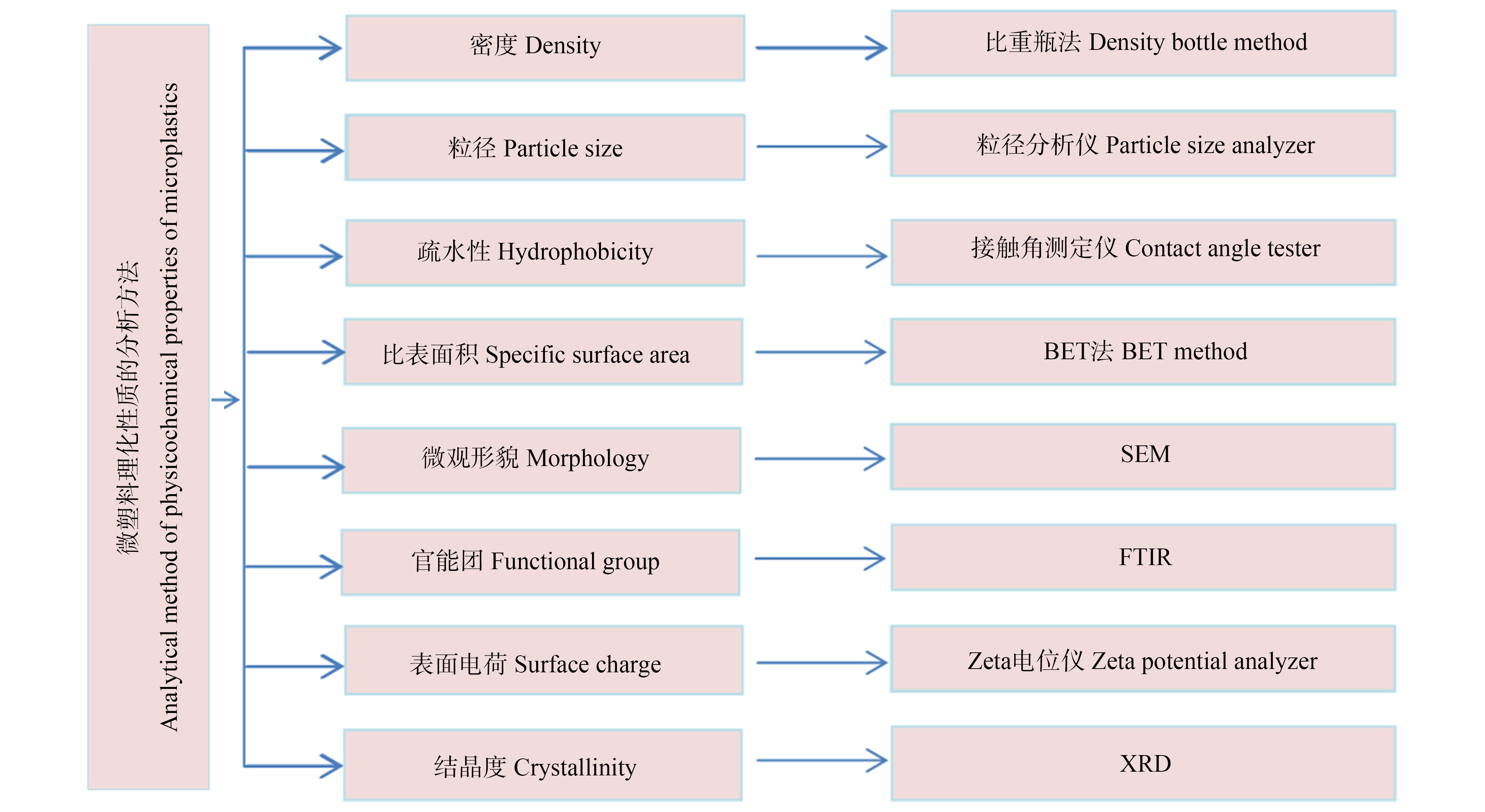
图1 微塑料理化性质的测定
注:SEM为扫描电子显微镜;FTIR为傅里叶变换红外光谱仪;XRD为X射线衍射仪。
Fig.1 Determination of physicochemical properties of microplastics
Note:SEM represents scanning electron microscope;FTIR represents Fourier transform infrared spectrometer;XRD represents X-ray diffractometer.
1.1 微塑料表观形貌的改变
微塑料表观形貌的改变表现在其形貌破碎、粒径减小、颜色变黄、粗糙度和比表面积增大。陈涛[29]、Brandon等[30]和Li等[31]采用原位暴露实验,发现暴露于近海环境下聚乙烯(polyethylene,PE)、聚丙烯(polypropylene,PP)等微塑料的表面形貌存在破碎现象,其粒径也显著减小,这主要归因于海洋环境中的物理碰撞、机械摩擦和光氧化等作用[32]。同时微塑料的颜色变黄[29],可能是由于藻类和微生物在基质表面的附着。SEM的结果(图2(a)和图2(b))也证实微塑料表面定殖有棒状、丝状、球形、栅栏状、盒状、螺旋状的细菌以及藻类和虫类等生物[14,33-37]。由于微生物的附着,微塑料的表面变得粗糙,并产生孔隙和折痕[31,38](图2(c))。这些产生的孔隙、折痕结构和黏附在微塑料表面的微生物分泌物一起使得微塑料的粗糙度和比表面积增大[14]。此外,Zettler等[14]和Reisser等[37]通过SEM观察发现微塑料表面具有符合微生物形状的凹坑和凹槽(图2(d)),表明生物膜上的微生物可能对微塑料降解起到重要作用。基于此,前人开展了大量关于海洋环境下微塑料降解菌的研究[27,39-43]。例如,Harshvardhan和Jha[40]研究发现Kocuria palustris M16、Bacillus pumilus M27和Bacillus subtilis H1584均能使PE发生生物降解,且在30 d内PE的质量损失分别为1%、1.5%和1.75%。塑料降解菌的存在促使微塑料自身的理化性质发生变化,如形状改变、质量及分子量减小、粗糙度增大、疏水性降低、结晶度和官能团变化等[37,39-40,44-46],其环境行为也随之发生改变,但微塑料降解所带来的新的环境效应还难以有效界定。同时需要加强关于从自然环境中筛选和鉴定微塑料降解能力强的降解菌的研究,这对微塑料在海洋中的风险防控具有重要意义。
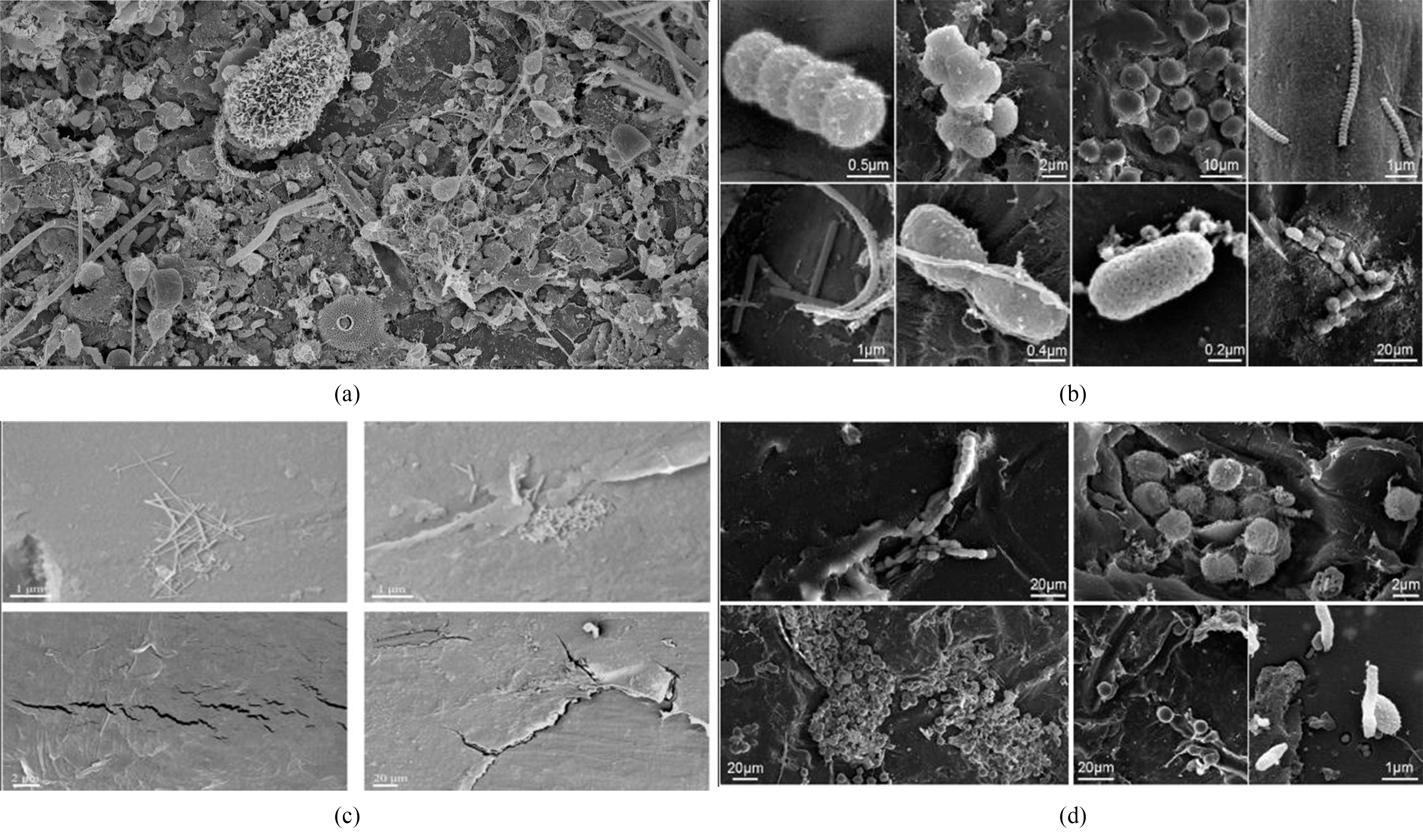
图2 微塑料表面SEM图
注:(a)微塑料表面丰富的微生物群落[35];(b)形态各异的微生物[37];(c)微塑料表面的孔隙和折痕[31];(d)微塑料表面符合微生物形状的凹坑和凹槽[37]。
Fig.2 SEM images of the surface morphology of microplastics
Note:(a) Abundant microbial communities on the surface of microplastics[35];(b) Microorganisms with various shapes[37]; (c) Pore and creases on the surface of microplastics[31];(d) Pits and grooves on the surface of microplastics due to microorganism adhesions[37].
1.2 生物膜的表面成分和立体结构
前人利用扫描电镜-能谱仪对微塑料附着生物膜的表面成分进行了深入探究。Leiser等[47]研究发现孵育PE微塑料的笼壁生物膜主要由水(约占生物膜质量的77%)、有机物质(约2%)和无机成分(约21%)组成(鉴于笼壁生物膜和PE表面生物膜的相似性,可外推至微塑料颗粒)。微塑料表面生物膜中含量最多的元素是碳,其次是氧,然后是硅、铝和铁,其余元素如钙、氯、钾、镁、锰、钠、磷、硫和钛的含量最少[48-49]。激光扫描共聚焦荧光显微镜(laser scanning confocal microscopy,LSCM)的结果表明,随着暴露时间的延长,微塑料表面的生物膜不断增厚[29,34]。如图3所示[50-51],在暴露初期,生物膜内以活细胞为主,随着暴露时间的延长,活菌大量繁殖,并开始产生少量死细胞,产生的死细胞又逐渐失去黏附能力,从基质上脱落[29,33],同时产生蛋白质、多糖等胞外聚合物(extracellular polymeric substances,EPS)。生物膜表面EPS的含量随着暴露时间的增加而不断升高[29,34,52]。鉴于EPS能够显著影响微生物在微塑料上的定殖及生物膜的形成,进而影响微塑料的环境行为[53-54],因此研究微塑料表面生物膜EPS对微塑料及共污染物环境行为的影响具有重要意义,但目前此方面的研究还极为少见。
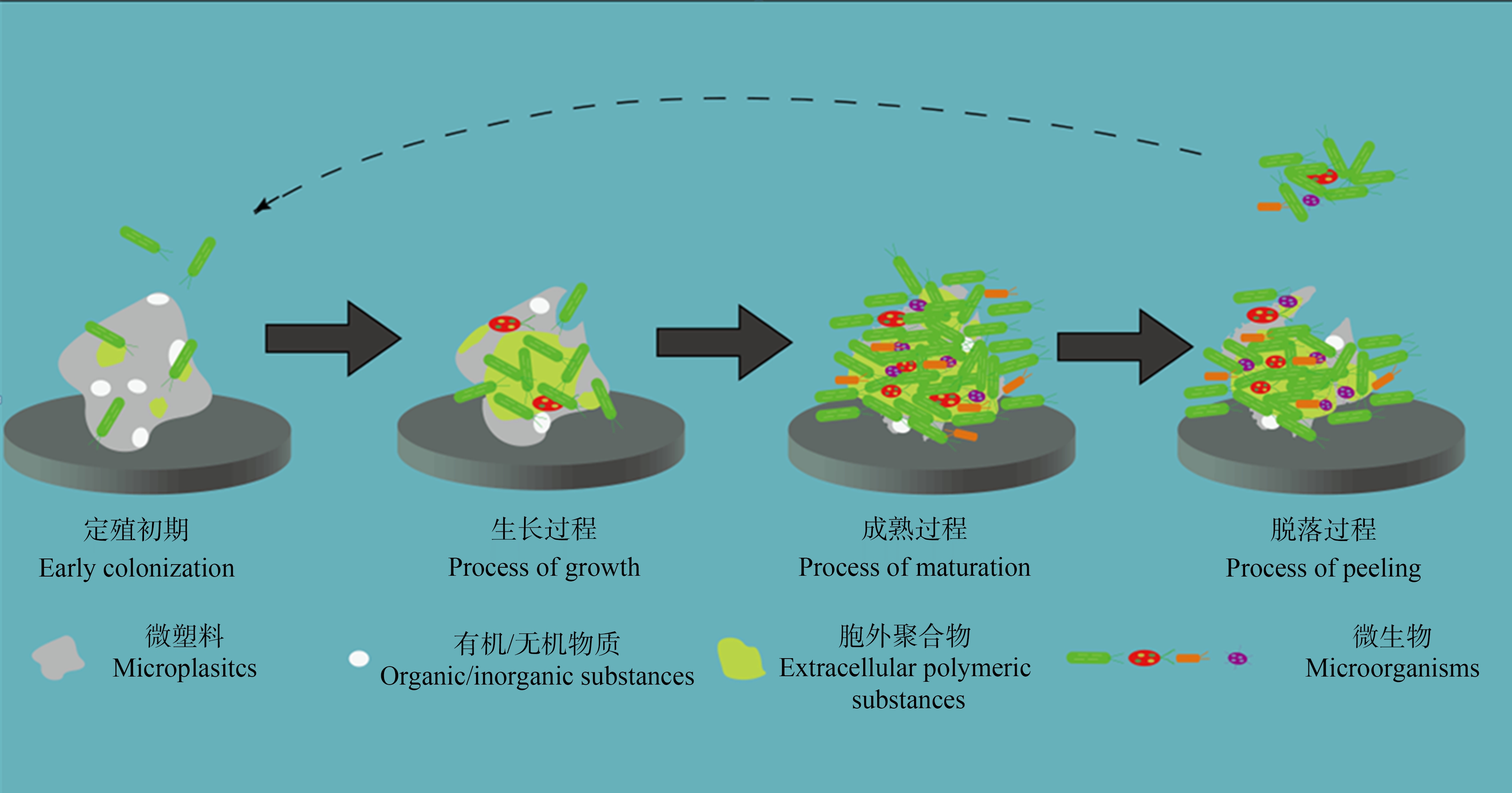
图3 微塑料表面生物膜的形成过程
Fig. 3 Succession of biofilm on microplastic surface
1.3 微塑料表面生物膜的群落结构
前人采用宏基因组学技术对微塑料上的微生物进行了鉴定,发现在生物膜形成初期,以α-变形菌纲和γ-变形菌纲为主的微生物率先大量定殖[55-56],后逐渐形成以变形菌门(Proteobacteria)、拟杆菌门(Bacteroidetes)和厚壁菌门(Firmicutes),α-变形菌纲(Alphaproteobacteria)和鞘脂杆菌纲(Sphingobacteria),假单胞菌科(Pseudomonadaceae)、红细菌科(Rhodobacteraceae)和赤杆菌科(Erythrobacteraceae),芽孢杆菌属(Bacillus)和假单胞菌属(Pseudomonas)为优势菌的生物膜群落结构[31,57-61]。随后藻类开始大量附着(包括硅藻门、绿藻门和蓝藻门等),并逐渐占据生物膜的主要空间[47,62-64]。附着的微生物能够有效联系微塑料表面的生物和非生物过程,如对碳的利用,参与氮磷循环等,进而影响微塑料在海洋环境中的命运[65-67]。因此微塑料上微生物介导的生物地球化学循环过程值得深入研究和讨论。另外,研究证明生物膜中鞘翅目(Coleoptera)中的部分成员(如赤杆菌科(Erythrobacteraceae)和红杆菌属(Erythrobacillus))以及优势门厚壁菌门能够降解芳香烃和卤代烃类污染物[68-69],而芽孢杆菌属(Bacillus)、红球菌属(Rhodococcus)、节杆菌属(Arthrobacter)和假单胞菌属(Pseudomonas)具有降解塑料基质的潜力[28,39,69],因此未来可能需要更多的研究探讨微塑料表面微生物对吸附污染物和基质本身的降解。同时在微塑料表面生物膜中也发现了Arcobacter spp.、Colwellia spp.、Escherichia spp.和Pseudomonas spp.等潜在致病菌属及有害硅藻物种[69]。但微塑料表面定殖的致病菌的来源和特征解析,以及其对微塑料在海洋中的生态毒性影响,还亟待研究。
1.4 微塑料表面官能团和晶体结构的改变
海水中生物膜的附着会导致微塑料自身官能团的形成和消失[31]。对于PE,在FTIR光谱上观察到了其C![]() O峰(1 500~1 700 cm-1)[30-31,34,49,70-72]、—OH峰(3 000~3 700 cm-1)[30-31,45,70]、C
O峰(1 500~1 700 cm-1)[30-31,34,49,70-72]、—OH峰(3 000~3 700 cm-1)[30-31,45,70]、C![]() C峰(950~1 200 cm-1、1 635~1 650 cm-1、3 200~3 400 cm-1)[33,45,70]、C—O峰(1 000 cm-1左右)[30,34]、O—C
C峰(950~1 200 cm-1、1 635~1 650 cm-1、3 200~3 400 cm-1)[33,45,70]、C—O峰(1 000 cm-1左右)[30,34]、O—C![]() O峰(1 734 cm-1)[70-71]的振动和增强,同时也能够观察到C—H峰(3 000~3 050 cm-1)的振动[43]。对于PP[29],观察到C—O峰(1 000 cm-1左右)[29]和—OH峰(3 391 cm-1)[45]的振动。对于聚对苯二甲酸乙二醇酯(polyethylene glycol terephthalate,PET)[31],观察到C—O峰(1 000 cm-1左右)和—OH峰(3 700~3 000 cm-1)的振动,同时Auta等[41]观察到PP上C
O峰(1 734 cm-1)[70-71]的振动和增强,同时也能够观察到C—H峰(3 000~3 050 cm-1)的振动[43]。对于PP[29],观察到C—O峰(1 000 cm-1左右)[29]和—OH峰(3 391 cm-1)[45]的振动。对于聚对苯二甲酸乙二醇酯(polyethylene glycol terephthalate,PET)[31],观察到C—O峰(1 000 cm-1左右)和—OH峰(3 700~3 000 cm-1)的振动,同时Auta等[41]观察到PP上C![]() O、—OH和C—H的振动峰随着生物膜的形成而消失,进一步证实生物膜内的微生物可能会利用微塑料基质进行自身的新陈代谢。微塑料官能团的变化与其环境行为紧密相关,但这种变化是否由生物膜内微生物引起,尚需深入探究。例如,微塑料表面存在的C
O、—OH和C—H的振动峰随着生物膜的形成而消失,进一步证实生物膜内的微生物可能会利用微塑料基质进行自身的新陈代谢。微塑料官能团的变化与其环境行为紧密相关,但这种变化是否由生物膜内微生物引起,尚需深入探究。例如,微塑料表面存在的C![]() O峰可能是由于生物膜中的微生物进行生物降解时,利用加氧酶(如漆酶)向碳链中添加氧元素所导致[31,33-34,71-72],也可能是风化等自然因素使微塑料发生氧化作用,氧原子与微塑料的碳链结合形成了羰基化合物[30,45,49,70,73];C
O峰可能是由于生物膜中的微生物进行生物降解时,利用加氧酶(如漆酶)向碳链中添加氧元素所导致[31,33-34,71-72],也可能是风化等自然因素使微塑料发生氧化作用,氧原子与微塑料的碳链结合形成了羰基化合物[30,45,49,70,73];C![]() C峰的存在表明微塑料正在发生降解[29,72,74],此时细菌可能通过酶途径诱导脂肪酸脱羧和聚酮合成产生烯烃[33],也可能是由于EPS的存在导致的C
C峰的存在表明微塑料正在发生降解[29,72,74],此时细菌可能通过酶途径诱导脂肪酸脱羧和聚酮合成产生烯烃[33],也可能是由于EPS的存在导致的C![]() C峰振动[45];C—O峰的存在表明微塑料表面产生了芳香族和脂肪族化合物[29,34,45,75];—OH峰的存在表明聚合物在生物降解时,主链亚甲基化形成了叔醇等物质[31,45];O—C
C峰振动[45];C—O峰的存在表明微塑料表面产生了芳香族和脂肪族化合物[29,34,45,75];—OH峰的存在表明聚合物在生物降解时,主链亚甲基化形成了叔醇等物质[31,45];O—C![]() O峰的存在表明微塑料发生了氧化[70-71],但主导氧化的因素尚不清晰;C—H峰的振动可能是由于微塑料表面脂质或者蛋白质的存在[43]。目前关于海洋环境下聚苯乙烯(polystyrene,PS)的光谱学研究较为少见,但Guan等[48]通过在淡水环境下对PS的FTIR研究得出相似的结果,表明水域环境可能不是影响微塑料官能团变化的主要因素。对于微塑料晶体结构的研究可为探究微生物的降解机制提供有效的路径,但目前的研究多集中于微生物群落对微塑料晶体结构共同的影响,群落中不同种类的微生物对其晶体结构各自的影响还缺乏定性和定量研究。另外,关于微生物附着于微塑料并利用微塑料作为碳源的新陈代谢机制尚不完全明确,缺乏在原子水平上相关系统深入的研究。
O峰的存在表明微塑料发生了氧化[70-71],但主导氧化的因素尚不清晰;C—H峰的振动可能是由于微塑料表面脂质或者蛋白质的存在[43]。目前关于海洋环境下聚苯乙烯(polystyrene,PS)的光谱学研究较为少见,但Guan等[48]通过在淡水环境下对PS的FTIR研究得出相似的结果,表明水域环境可能不是影响微塑料官能团变化的主要因素。对于微塑料晶体结构的研究可为探究微生物的降解机制提供有效的路径,但目前的研究多集中于微生物群落对微塑料晶体结构共同的影响,群落中不同种类的微生物对其晶体结构各自的影响还缺乏定性和定量研究。另外,关于微生物附着于微塑料并利用微塑料作为碳源的新陈代谢机制尚不完全明确,缺乏在原子水平上相关系统深入的研究。
1.5 微塑料其他性质的改变
生物膜的附着会导致微塑料密度增大,从而易在水体中沉降[25,29,36,76]。但是张晨捷等[36]在海岸带环境对低密度聚乙烯(low density polyethylene,LDPE)的研究表明,长时间的暴露后微塑料的密度反而会减小,其原因可能是非生物因素和生物因素的共同作用导致微塑料表面发生风化,聚合物链断裂。因而暴露于水体的微塑料可能会由于密度的变化而发生反复的沉降和再悬浮行为。Lobelle和Cunliffe[25]、陈涛[29]和Tu等[34]的研究显示,随着暴露时间的增加,生物膜逐渐形成,而形成于微塑料表面的亲水性生物膜降低了微塑料的疏水性。另外,Wang等[77]的研究表明,附着的生物膜降低了微塑料表面的Zeta电位。微塑料这些性质的改变进一步影响微塑料表面微生物的定殖及其环境行为,但目前对于三者间的关系还有待深入研究。
1.6 微生物定殖的影响因素
影响微生物定殖的因素主要表现在3个方面:基质自身结构和性质[35,68,78]、环境条件(暴露时间[25,29,34]、营养物质[59,79]、盐度[55,58-59,79]、季节变化[63,74,80]、地理位置[80]、温度[81]、光照[68]、pH[71])和其他化学因素(如表面活性剂[68]、溶解性有机碳[82]、抗生素和金属[78])。
1.6.1 微塑料自身结构和性质
微塑料的疏水性、粗糙度是影响微生物群落结构的重要因素[35],而其形状、粒径等性质对微生物群落影响不大[68]。较低的疏水性,较高的粗糙度和比表面积往往使微塑料表面含有丰富的生物量,因为其为微生物在微塑料表面的定殖提供更多的接触位点[83]。因此,在相同暴露时间下,PE表面生物膜密度最高[83-84]。
1.6.2 环境条件
与微塑料类型相比,环境因素更能够影响微生物的定殖[31,85]。生物膜密度通常随着暴露时间、营养物质含量(总氮和总磷)的增加而增加,随着暴露深度和盐度的增加而降低[25,29,34,79,86]。季节不同,微塑料表面微生物群落结构也显著不同,且从冬季到夏季,微塑料上附着生物膜厚度不断增加[63,87],微生物群落的季节性变化可能与温度和光照有关,因为在适宜温度范围内,较高的温度会增加细胞代谢,促进微生物繁殖,微生物群落结构也更丰富[80-81]。而光照对微生物定殖的影响主要表现在3点:光照使得微塑料氧化分解后,其表面变得更粗糙,具有更多的孔、裂纹和凹槽,能够提供微生物更多的附着位点[68];部分微生物能够利用微塑料分解释放的烷烃、烯烃、酮、醛和醇等小分子产物进行自身的分解代谢[88-92];微塑料被光氧化分解后易形成一些羰基、酯基、乙烯基和羟基等极性官能团并导致其疏水性的降低,促进其与微生物的接触[71,74,93]。温度和光照对微生物定殖的影响也解释了为什么随着暴露深度的增加,微塑料表面生物膜密度降低[86]。相较于基质自身结构,环境因素对微塑料上微生物定殖的影响更为强烈,但是目前关于各环境因子对微生物定殖的影响强弱、各环境因子之间对其定殖的协同作用还有待于研究。
1.6.3 其他化学因素
在实际环境中一些化学因素的存在对微生物定殖的影响不容忽视,因为其可能直接影响到微塑料的生态毒性。例如,表面活性剂的存在能够降低微塑料表面的疏水性,促进微生物对微塑料的接触,同时潜在病原菌更倾向于在含有表面活性剂的微塑料上定殖[68];抗生素和金属的存在能显著降低微塑料上细菌群落结构的丰富度,且多种抗生素的复合污染会导致更强的抑制作用,同时抗生素和金属的存在还可能会促进携带抗生素抗性基因和金属抗性基因的细菌大量繁殖[78]。但目前对微塑料表面携带抗性基因的微生物的相关研究还比较缺乏,其给海洋环境带来的新的生态效应还有待探究。
2 生物膜的形成对微塑料环境行为的影响(Effects of biofilm formation on environmental behavior of microplastics)
微生物在微塑料表面大量繁殖改变了微塑料的理化性质,进而影响其沉降行为和吸附行为。图4展示了海洋环境下附着生物膜前后微塑料环境行为的改变。

图4 海洋环境下附着生物膜前后微塑料的环境行为改变
注:红色和绿色箭头分别表示微塑料对有机污染物和重金属的吸附机理。
Fig.4 Environmental behavior of microplastics before and after biofilm attachment in the marine environment
Note:The red and green arrows represent the adsorption mechanism of organic pollutants and heavy metals by microplastics respectively.
2.1 沉降行为
PE、PP和PS等密度较低的微塑料在海洋水体中以分散或悬浮固体颗粒的形式存在[94],但是聚氯乙烯(polyvinyl chloride,PVC)、PET和聚酰胺(polyamide,PA)等相较于海水密度更大的微塑料,则会沉降于海洋沉积物中[7,54,95]。研究表明生物膜形成增大了微塑料密度,使原本漂浮在海面和悬浮在海水中密度较轻的微塑料发生沉降作用[25,63,85,96-97]。且微塑料比表面积越大,生物膜形成速度越快,微塑料的沉降行为越快发生[97]。当微塑料下沉至一定深度时,由于微塑料表面生物膜得不到足够的营养物质和光照,又会逐渐脱落,微塑料又重新浮出水面漂浮[97]。沉降使得原本漂浮在海面易受到光降解的微塑料变得不易降解。
关于生物膜对微塑料沉降迁移行为的影响,学界已开展了一定研究。例如,Kooi等[98]设计了一个数学模型来模拟海洋环境中生物膜及其他环境因素对微塑料垂直迁移行为的影响,为微塑料在海洋中迁移的模型化探究提供了一个开端。Kaiser等[62]研究发现由于生物膜的形成,在河口和大西洋水中暴露2周的PS的沉降速度较原始颗粒分别增加了5%和6%。Leiser等[47]的研究显示在富营养化水库中暴露29 d后,约10%~15%的PE由于生物膜的形成而失去浮力下沉。进而学者对其沉降机理进行了探究,发现生物膜促进微塑料沉降的机理主要表现在4个方面:生物膜中富含的CaCO3等无机和有机物质增大了微塑料密度[47,63];生物膜表面定殖的硅藻等藻类有助于微塑料形成团聚体,从而促进沉降[99-100];生物膜的存在能够降低微塑料表面电荷,从而使得其沉降迁移行为更易发生[101];微生物分泌的EPS有助于微塑料颗粒的沉降[101]。但目前对于生物因素介导下微塑料在海洋中的迁移行为探究还缺乏一个整体的系统认知,相关模拟计算和理论机制探究还极为缺乏。
2.2 吸附行为
吸附有机、无机营养物质及部分环境污染物后的微塑料能够快速吸引微生物定殖到其表面,形成生物膜[76]。形成的生物膜又能够进一步改变微塑料的吸附特性。前人对微塑料吸附行为的研究集中在重金属和有机污染物2个方面,且研究表明,与吸附有机污染物相比,生物膜的形成对微塑料吸附重金属的影响更大[102]。表1总结了海洋环境下微塑料的吸附行为及其机理。
表1 海洋环境下微塑料的吸附行为及其机理分析
Table 1 Adsorption behavior and mechanism of microplastics in the marine environment
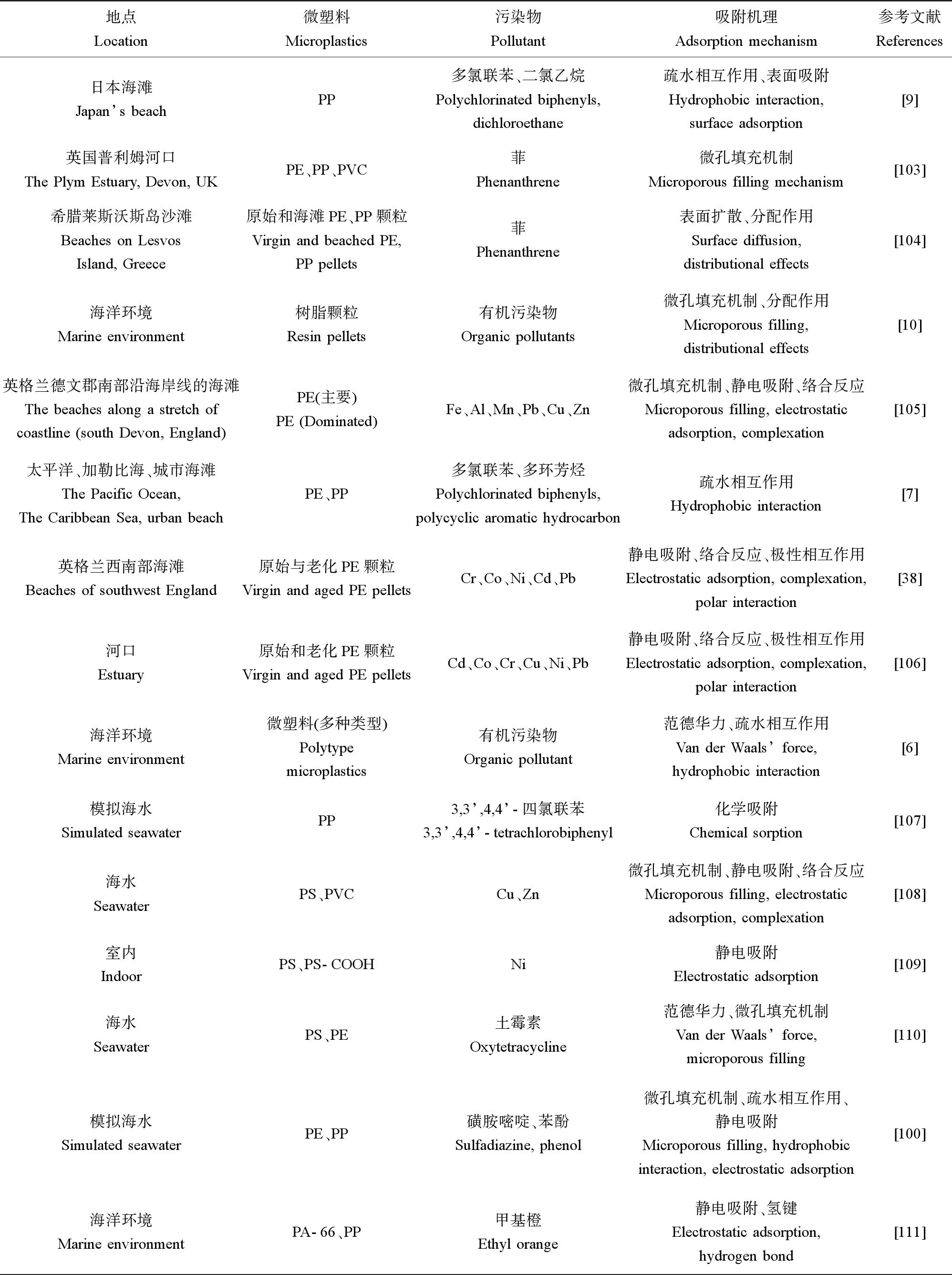
地点Location微塑料Microplastics污染物Pollutant吸附机理Adsorption mechanism参考文献References日本海滩Japan’s beachPP多氯联苯、二氯乙烷Polychlorinated biphenyls, dichloroethane疏水相互作用、表面吸附Hydrophobic interaction, surface adsorption[9]英国普利姆河口The Plym Estuary, Devon, UKPE、PP、PVC菲Phenanthrene微孔填充机制Microporous filling mechanism[103]希腊莱斯沃斯岛沙滩Beaches on Lesvos Island, Greece原始和海滩PE、PP颗粒Virgin and beached PE, PP pellets菲Phenanthrene表面扩散、分配作用Surface diffusion, distributional effects[104]海洋环境Marine environment树脂颗粒Resin pellets有机污染物Organic pollutants微孔填充机制、分配作用Microporous filling, distributional effects[10]英格兰德文郡南部沿海岸线的海滩The beaches along a stretch of coastline (south Devon, England)PE(主要)PE (Dominated)Fe、Al、Mn、Pb、Cu、Zn微孔填充机制、静电吸附、络合反应Microporous filling, electrostatic adsorption, complexation[105]太平洋、加勒比海、城市海滩The Pacific Ocean, The Caribbean Sea, urban beachPE、PP多氯联苯、多环芳烃Polychlorinated biphenyls, polycyclic aromatic hydrocarbon疏水相互作用Hydrophobic interaction[7]英格兰西南部海滩Beaches of southwest England原始与老化PE颗粒Virgin and aged PE pelletsCr、Co、Ni、Cd、Pb静电吸附、络合反应、极性相互作用Electrostatic adsorption, complexation, polar interaction[38]河口Estuary原始和老化PE颗粒Virgin and aged PE pelletsCd、Co、Cr、Cu、Ni、Pb静电吸附、络合反应、极性相互作用Electrostatic adsorption, complexation, polar interaction[106]海洋环境Marine environment微塑料(多种类型)Polytype microplastics有机污染物Organic pollutant范德华力、疏水相互作用Van der Waals’ force, hydrophobic interaction[6]模拟海水Simulated seawaterPP3,3’,4,4’-四氯联苯3,3’,4,4’-tetrachlorobiphenyl化学吸附Chemical sorption[107]海水SeawaterPS、PVCCu、Zn微孔填充机制、静电吸附、络合反应Microporous filling, electrostatic adsorption, complexation[108]室内IndoorPS、PS-COOHNi静电吸附Electrostatic adsorption[109]海水SeawaterPS、PE土霉素Oxytetracycline范德华力、微孔填充机制Van der Waals’ force, microporous filling[110]模拟海水Simulated seawaterPE、PP磺胺嘧啶、苯酚Sulfadiazine, phenol微孔填充机制、疏水相互作用、静电吸附Microporous filling, hydrophobic interaction, electrostatic adsorption[100]海洋环境Marine environmentPA-66、PP甲基橙Ethyl orange静电吸附、氢键Electrostatic adsorption, hydrogen bond[111]
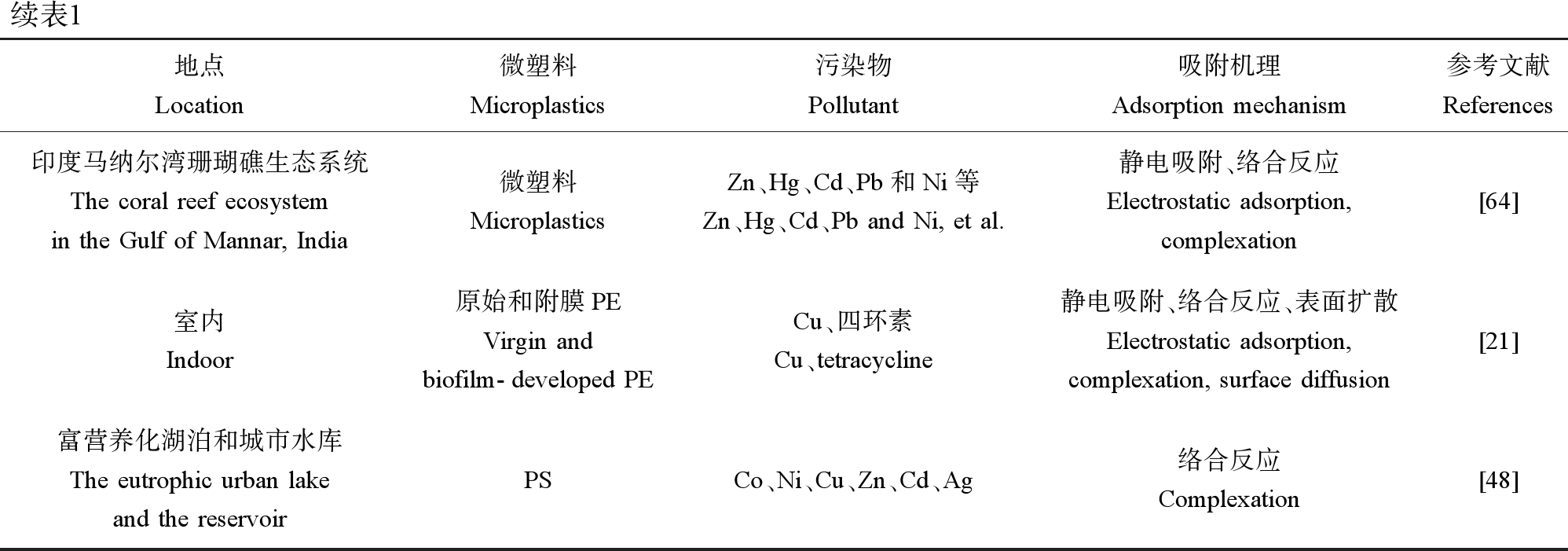
续表1地点Location微塑料Microplastics污染物Pollutant吸附机理Adsorption mechanism参考文献References印度马纳尔湾珊瑚礁生态系统The coral reef ecosystem in the Gulf of Mannar, India微塑料MicroplasticsZn、Hg、Cd、Pb和Ni等Zn、Hg、Cd、Pb and Ni, et al.静电吸附、络合反应Electrostatic adsorption, complexation[64]室内Indoor原始和附膜PEVirgin and biofilm-developed PECu、四环素Cu、tetracycline静电吸附、络合反应、表面扩散Electrostatic adsorption, complexation, surface diffusion[21]富营养化湖泊和城市水库The eutrophic urban lake and the reservoirPSCo、Ni、Cu、Zn、Cd、Ag络合反应Complexation[48]
注:PP表示聚丙烯;PS表示聚苯乙烯;PE表示聚乙烯;PVC表示聚氯乙烯;PS-COOH表示带有羧基官能团的聚苯乙烯;PA-66表示聚酰胺-66。
Note:PP represents polypropylene;PS represents polystyrene;PE represents polyethylene;PVC represents polyvinyl chloride;PS-COOH represents polystyrene that coated with a carboxyl group;PA-66 represents polyamide-66.
2.2.1 生物膜的形成对微塑料吸附重金属的影响
重金属阳离子或其络合物可以通过静电作用和络合反应直接吸附到原始微塑料表面的带电点位或中性区域[21,38,105],但其吸附效果并不明显。前人的研究已表明暴露于海洋环境中的微塑料可从海水或沉积物介质中吸附Hg2+、Cd2+等重金属离子[64,102,112],且微塑料表面生物膜有助于重金属在微塑料上的富集[48,113]。例如,Johansen等[49]在南太平洋的一项研究表明未附膜的PP对核素134Cs和85Sr的吸附量仅为附膜PP的1.0%~1.6%。生物膜形成后,重金属在微塑料上的吸附扩散由颗粒表面扩散机制转变为膜扩散机制[18,21,48,77]。同时生物膜中含有的可电离基团(氨基、羟基、羰基、羧基、磷酰基、酮基和苯基)增强了微塑料与重金属离子的亲和力,并与重金属发生强络合反应,由此增强了微塑料的吸附能力[48,77,105,114]。而研究表明强络合反应是生物膜提高微塑料对重金属吸附能力的首要原因[21,38,48,106]。Wang等[21]通过密度泛函理论对生物膜与Cu2+之间的络合反应进行了深入探究,发现生物膜成分中的1,2-二甲基酯上的第12位O原子和第19位O原子,2,4二甲基-7,8-苯并喹啉中的第21位N原子和1,2-苯二甲酸1-(2-乙基己基)酯中的第41位O原子可能是与Cu2+发生络合反应的结合位点。此外,生物膜与微塑料的互作能够影响如菌毛、鞭毛一类的微生物表面结构,从而调节生物膜分泌的具有粘性的EPS,改变微塑料的吸附能力[99,114]。
2.2.2 生物膜的形成对微塑料吸附有机污染物的影响
马丽娜[100]、张凯娜[110]、宋欢[111]、石双双[115]、Guo和Wang[116]、Li等[117]研究了暴露于海水环境中微塑料对有机污染物的吸附机理,发现微塑料在海洋环境中主要通过与疏水性污染物的疏水相互作用、分子间范德华力、微孔填充机制、氢键和静电相互作用等方式吸附污染物。另外,Li等[117]和Xu等[118]发现由于π-π键和范德华力相互作用,PS对有机污染物的吸附能力较PE和PP更大。与原始微塑料相比,暴露于海洋环境中的微塑料对污染物具有更高的亲和力[9,104],这主要归因于微塑料表面生物膜的形成[21,85]。生物膜的形成增大了微塑料的比表面积,提高了污染物的有效扩散面积并提供了更多的吸附位点[21]。另外,由于生物膜内含有大量极性基团,微塑料与污染物之间存在极性相互作用。同时一些极性化学键如π-π键、氢键也可以与污染物相互作用从而增强微塑料对污染物的吸附[111,119-120]。另外,由于生物膜的形成使微塑料带上电荷,微塑料则可以通过静电力吸附带电荷的有机污染物[77,120]。因此生物膜充当了微塑料吸附污染物真正的活性层[85]。
综上,生物膜的形成能够改变微塑料的表面电荷、粗糙度、孔隙率、亲水性和极性官能团,从而改变微塑料的吸附能力。生物膜形成前后,污染物在微塑料表面主要的扩散机制分别是颗粒表面扩散和膜扩散[21]。附着生物膜的微塑料对重金属的吸附主要依靠络合反应,而对有机污染物的吸附主要依靠静电相互作用和氢键、π-π键等化学键。此外,生物膜分泌的粘性EPS也参与了微塑料对污染物的吸附,其能与重金属离子发生络合反应,与有机污染物通过氢键和静电力相互作用[77,121]。但是目前关于生物膜的形成对微塑料吸附行为的影响,特别是微米、纳米尺度的微塑料的吸附效应及其与微生物的互作研究、生物膜介导的微塑料解吸行为以及与污染物的共迁移行为相关探究较为缺乏,亟待更加深入系统的研究。
3 结语与展望(Conclusions and perspectives)
鉴于海洋环境中(微)塑料污染问题日益严重,开展关于微塑料在该系统中的环境行为和生态风险研究的意义重大。本文主要综述了海洋环境下微生物群落的定殖对微塑料的理化性质和环境行为的影响。从生物膜角度探讨微塑料在海洋环境中的环境效应,可为微塑料的海洋风险评估提供借鉴,具有现实意义。但是目前学界关于微生物与微塑料的互作研究还存在以下问题,尚需深入研究。
(1)当前学界多关注大洋和普通近海环境中微塑料污染问题,但在红树林区、海草床和珊瑚礁区等特殊海洋生态系统中微塑料的赋存及生态效应方面的研究还明显不足,其中的很多科学问题仍不清楚。
(2)由于生物膜的附着增加了微塑料的密度,进入海洋中的微塑料会发生沉降作用,并在沉积物区域积累。因此,明确海洋底层沉积物中微塑料的迁移行为是迫切需要解决的问题。
(3)鉴于生物膜的形成可影响微塑料的表面性质,未来需要加强微塑料与微生物互作关系方面的研究,特别是形成生物膜后微生物和其他因素的共降解作用对微塑料难降解特性的改变和微塑料作为致病菌或抗性基因传播的工具。
(4)目前的研究多偏重于原始微塑料颗粒对污染物环境行为和生物有效性等的研究,对自然暴露后微塑料与污染物的界面微观作用机制研究仍处于初始阶段,尚未形成较为系统的应用理论基础。此外,附膜后微塑料与污染物的复合作用对海洋生物的毒性效应也较为匮乏。
[1] Galloway T S,Lewis C N.Marine microplastics spell big problems for future generations [J].Proceedings of the National Academy of Sciences of the United States of America,2016,113(9):2331-2333
[2] 董翔宇,单子豪,袁文静,等.海洋环境微塑料污染生态影响及生物降解研究进展[J].中国资源综合利用,2020,38(11):122-124
Dong X Y,Shan Z H,Yuan W J,et al.Research progress on ecological impact and biodegradation of microplastics in marine environment [J].China Resources Comprehensive Utilization,2020,38(11):122-124 (in Chinese)
[3] Thompson R C,Olsen Y,Mitchell R P,et al.Lost at sea:Where is all the plastic?[J].Science,2004,304(5672):838
[4] Horton A A,Walton A,Spurgeon D J,et al.Microplastics in freshwater and terrestrial environments:Evaluating the current understanding to identify the knowledge gaps and future research priorities [J].The Science of the Total Environment,2017,586:127-141
[5] Cole M,Lindeque P,Halsband C,et al.Microplastics as contaminants in the marine environment:A review [J].Marine Pollution Bulletin,2011,62(12):2588-2597
[6] Wang J D,Tan Z,Peng J P,et al.The behaviors of microplastics in the marine environment [J].Marine Environmental Research,2016,113:7-17
[7] Hirai H,Takada H,Ogata Y,et al.Organic micropollutants in marine plastics debris from the open ocean and remote and urban beaches [J].Marine Pollution Bulletin,2011,62(8):1683-1692
[8] Bakir A,Rowland S J,Thompson R C.Enhanced desorption of persistent organic pollutants from microplastics under simulated physiological conditions [J].Environmental Pollution,2014,185:16-23
[9] Mato Y,Isobe T,Takada H,et al.Plastic resin pellets as a transport medium for toxic chemicals in the marine environment [J].Environmental Science &Technology,2001,35(2):318-324
[10] Teuten E L,Saquing J M,Knappe D R U,et al.Transport and release of chemicals from plastics to the environment and to wildlife [J].Philosophical Transactions of the Royal Society of London Series B,Biological Sciences,2009,364(1526):2027-2045
[11] Setälä O,Fleming-Lehtinen V,Lehtiniemi M.Ingestion and transfer of microplastics in the planktonic food web [J].Environmental Pollution,2014,185:77-83
[12] Fueser H,Mueller M T,Traunspurger W.Ingestion of microplastics by meiobenthic communities in small-scale microcosm experiments [J].Science of the Total Environment,2020,746:141276
[13] 刘涛.微塑料在黄东海的分布及其在浮游动物体内累积的研究[D].北京:中国科学院大学,2017:6-8
Liu T.Distribution of microplastics and its accumulation in zooplankton in the Yellow Sea and East China Sea [D].Beijing:University of Chinese Academy of Sciences,2017:6-8 (in Chinese)
[14] Zettler E R,Mincer T J,Amaral-Zettler L A.Life in the “plastisphere”:Microbial communities on plastic marine debris [J].Environmental Science &Technology,2013,47(13):7137-7146
[15] Wu N,Zhang Y,Zhao Z,et al.Colonization characteristics of bacterial communities on microplastics compared with ambient environments (water and sediment) in Haihe Estuary [J].The Science of the Total Environment,2020,708:134876
[16] Miao L Z,Wang P F,Hou J,et al.Distinct community structure and microbial functions of biofilms colonizing microplastics [J].The Science of the Total Environment,2019,650(Pt 2):2395-2402
[17] Miao L Z,Hou J,You G X,et al.Acute effects of nanoplastics and microplastics on periphytic biofilms depending on particle size,concentration and surface modification [J].Environmental Pollution,2019,255(Pt 2):113300
[18] Mammo F K,Amoah I D,Gani K M,et al.Microplastics in the environment:Interactions with microbes and chemical contaminants [J].The Science of the Total Environment,2020,743:140518
[19] Viršek M K,Lovšin M N,Koren  ,et al.Microplastics as a vector for the transport of the bacterial fish pathogen species Aeromonas salmonicida [J].Marine Pollution Bulletin,2017,125(1-2):301-309
,et al.Microplastics as a vector for the transport of the bacterial fish pathogen species Aeromonas salmonicida [J].Marine Pollution Bulletin,2017,125(1-2):301-309
[20] Wu X J,Pan J,Li M,et al.Selective enrichment of bacterial pathogens by microplastic biofilm [J].Water Research,2019,165:114979
[21] Wang Y,Wang X J,Li Y,et al.Biofilm alters tetracycline and copper adsorption behaviors onto polyethylene microplastics [J].Chemical Engineering Journal,2020,392:123808
[22] Qi K,Lu N,Zhang S Q,et al.Uptake of Pb(Ⅱ) onto microplastic-associated biofilms in freshwater:Adsorption and combined toxicity in comparison to natural solid substrates [J].Journal of Hazardous Materials,2021,411:125115
[23] Amaral-Zettler L A,Zettler E R,Slikas B,et al.The biogeography of the plastisphere:Implications for policy [J].Frontiers in Ecology and the Environment,2015,13(10):541-546
[24] 李宵慧,徐红霞,孙媛媛,等.多孔介质中微塑料的环境行为研究进展[J].中国环境科学,2021,41(6):2798-2811
Li X H,Xu H X,Sun Y Y,et al.Review on the environmental behaviors of microplastics in porous media [J].China Environmental Science,2021,41(6):2798-2811 (in Chinese)
[25] Lobelle D,Cunliffe M.Early microbial biofilm formation on marine plastic debris [J].Marine Pollution Bulletin,2011,62(1):197-200
[26] Rowlands E,Galloway T,Manno C.A Polar outlook:Potential interactions of micro- and nano-plastic with other anthropogenic stressors [J].The Science of the Total Environment,2021,754:142379
[27] Auta H S,Emenike C U,Fauziah S H.Screening of Bacillus strains isolated from mangrove ecosystems in Peninsular Malaysia for microplastic degradation [J].Environmental Pollution,2017,231(Pt 2):1552-1559
[28] Yuan J H,Ma J,Sun Y R,et al.Microbial degradation and other environmental aspects of microplastics/plastics [J].The Science of the Total Environment,2020,715:136968
[29] 陈涛.近海微塑料表面生物膜的形成及其对微塑料理化性质的影响[D].北京:中国科学院大学,2018:26-56
Chen T.Formation of biofilm on microplastics and its influences on physicochemical properties of microplastics in the coastal sea [D].Beijing:University of Chinese Academy of Sciences,2018:26-56 (in Chinese)
[30] Brandon J,Goldstein M,Ohman M D.Long-term aging and degradation of microplastic particles:Comparing in situ oceanic and experimental weathering patterns [J].Marine Pollution Bulletin,2016,110(1):299-308
[31] Li J J,Huang W,Jiang R J,et al.Are bacterial communities associated with microplastics influenced by marine habitats?[J].The Science of the Total Environment,2020,733:139400
[32] 周倩,章海波,周阳,等.滨海河口潮滩中微塑料的表面风化和成分变化[J].科学通报,2018,63(2):214-224
Zhou Q,Zhang H B,Zhou Y,et al.Surface weathering and changes in components of microplastics from estuarine beaches [J].Chinese Science Bulletin,2018,63(2):214-224 (in Chinese)
[33] Tarafdar A,Lee J U,Jeong J E,et al.Biofilm development of Bacillus siamensis ATKU1 on pristine short chain low-density polyethylene:A case study on microbe-microplastics interaction [J].Journal of Hazardous Materials,2021,409:124516
[34] Tu C,Chen T,Zhou Q,et al.Biofilm formation and its influences on the properties of microplastics as affected by exposure time and depth in the seawater [J].The Science of the Total Environment,2020,734:139237
[35] Kirstein I V,Wichels A,Krohne G,et al.Mature biofilm communities on synthetic polymers in seawater - Specific or general?[J].Marine Environmental Research,2018,142:147-154
[36] 张晨捷,涂晨,周倩,等.低密度聚乙烯薄膜微塑料在黄河口海岸带环境中的风化特征[J].土壤学报,2021,58(2):456-463
Zhang C J,Tu C,Zhou Q,et al.Weathering characteristics of microplastics of low density polyethylene film in the coastal environment of the Yellow River Estuary [J].Acta Pedologica Sinica,2021,58(2):456-463 (in Chinese)
[37] Reisser J,Shaw J,Hallegraeff G,et al.Millimeter-sized marine plastics:A new pelagic habitat for microorganisms and invertebrates [J].PLoS One,2014,9(6):e100289
[38] Holmes L A,Turner A,Thompson R C.Adsorption of trace metals to plastic resin pellets in the marine environment [J].Environmental Pollution,2012,160:42-48
[39] Sudhakar M,Doble M,Murthy P S,et al.Marine microbe-mediated biodegradation of low- and high-density polyethylenes [J].International Biodeterioration &Biodegradation,2008,61(3):203-213
[40] Harshvardhan K,Jha B.Biodegradation of low-density polyethylene by marine bacteria from pelagic waters,Arabian Sea,India [J].Marine Pollution Bulletin,2013,77(1-2):100-106
[41] Auta H S,Emenike C U,Jayanthi B,et al.Growth kinetics and biodeterioration of polypropylene microplastics by Bacillus sp.and Rhodococcus sp.isolated from mangrove sediment [J].Marine Pollution Bulletin,2018,127:15-21
[42] Urbanek A K,Strzelecki M C,Mirończuk A M.The potential of cold-adapted microorganisms for biodegradation of bioplastics [J].Waste Management,2021,119:72-81
[43] Paço A,Duarte K,da Costa J P,et al.Biodegradation of polyethylene microplastics by the marine fungus Zalerion maritimum [J].The Science of the Total Environment,2017,586:10-15
[44] Arkatkar A,Arutchelvi J,Bhaduri S,et al.Degradation of unpretreated and thermally pretreated polypropylene by soil consortia [J].International Biodeterioration &Biodegradation,2009,63(1):106-111
[45] Shabbir S,Faheem M,Ali N,et al.Periphytic biofilm:An innovative approach for biodegradation of microplastics [J].The Science of the Total Environment,2020,717:137064
[46] Balasubramanian V,Natarajan K,Hemambika B,et al.High-density polyethylene (HDPE)-degrading potential bacteria from marine ecosystem of Gulf of Mannar,India [J].Letters in Applied Microbiology,2010,51(2):205-211
[47] Leiser R,Jongsma R,Bakenhus I,et al.Interaction of cyanobacteria with calcium facilitates the sedimentation of microplastics in a eutrophic reservoir [J].Water Research,2021,189:116582
[48] Guan J N,Qi K,Wang J Y,et al.Microplastics as an emerging anthropogenic vector of trace metals in freshwater:Significance of biofilms and comparison with natural substrates [J].Water Research,2020,184:116205
[49] Johansen M P,Cresswell T,Davis J,et al.Biofilm-enhanced adsorption of strong and weak cations onto different microplastic sample types:Use of spectroscopy,microscopy and radiotracer methods [J].Water Research,2019,158:392-400
[50] 季梦如,马旖旎,季荣.微塑料圈:环境微塑料对微生物的载体作用[J].环境保护,2020,48(23):19-27
Ji M R,Ma Y N,Ji R.Plastisphere:The vector effects of microplastics on microbial communities [J].Environmental Protection,2020,48(23):19-27 (in Chinese)
[51] Wimpenny J.Ecological determinants of biofilm formation [J].Biofouling,1996,10(1-3):43-63
[52] Michels J,Stippkugel A,Lenz M,et al.Rapid aggregation of biofilm-covered microplastics with marine biogenic particles [J].Proceedings Biological Sciences,2018,285(1885):20181203
[53] Webb H K,Crawford R J,Sawabe T,et al.Poly(ethylene terephthalate) polymer surfaces as a substrate for bacterial attachment and biofilm formation [J].Microbes and Environments,2009,24(1):39-42
[54] Li S X,Wang P P,Zhang C,et al.Influence of polystyrene microplastics on the growth,photosynthetic efficiency and aggregation of freshwater microalgae Chlamydomonas reinhardtii [J].The Science of the Total Environment,2020,714:136767
[55] Yang Y Y,Liu W Z,Zhang Z L,et al.Microplastics provide new microbial niches in aquatic environments [J].Applied Microbiology and Biotechnology,2020,104(15):6501-6511
[56] Lee J W,Nam J H,Kim Y H,et al.Bacterial communities in the initial stage of marine biofilm formation on artificial surfaces [J].Journal of Microbiology (Seoul,Korea),2008,46(2):174-182
[57] De Tender C,Devriese L I,Haegeman A,et al.Temporal dynamics of bacterial and fungal colonization on plastic debris in the north sea [J].Environmental Science &Technology,2017,51(13):7350-7360
[58] Kesy K,Oberbeckmann S,Kreikemeyer B,et al.Spatial environmental heterogeneity determines young biofilm assemblages on microplastics in Baltic Sea mesocosms [J].Frontiers in Microbiology,2019,10:1665
[59] Oberbeckmann S,Kreikemeyer B,Labrenz M.Environmental factors support the formation of specific bacterial assemblages on microplastics [J].Frontiers in Microbiology,2017,8:2709
[60] Hou D D,Hong M,Wang K,et al.Prokaryotic community succession and assembly on different types of microplastics in a mariculture cage [J].Environmental Pollution,2021,268(Pt A):115756
[61] Xie H F,Chen J J,Feng L M,et al.Chemotaxis-selective colonization of mangrove rhizosphere microbes on nine different microplastics [J].The Science of the Total Environment,2021,752:142223
[62] Kaiser D,Kowalski N,Waniek J J.Effects of biofouling on the sinking behavior of microplastics [J].Environmental Research Letters,2017,12(12):124003
[63] Chen X C,Xiong X,Jiang X M,et al.Sinking of floating plastic debris caused by biofilm development in a freshwater lake [J].Chemosphere,2019,222:856-864
[64] Patterson J,Jeyasanta K I,Sathish N,et al.Microplastic and heavy metal distributions in an Indian coral reef ecosystem [J].The Science of the Total Environment,2020,744:140706
[65] Chen X C,Chen X F,Zhao Y H,et al.Effects of microplastic biofilms on nutrient cycling in simulated freshwater systems [J].The Science of the Total Environment,2020,719:137276
[66] Arias-Andres M,Kettner M T,Miki T,et al.Microplastics:New substrates for heterotrophic activity contribute to altering organic matter cycles in aquatic ecosystems [J].The Science of the Total Environment,2018,635:1152-1159
[67] Rogers K L,Carreres-Calabuig J A,Gorokhova E,et al.Micro-by-micro interactions:How microorganisms influence the fate of marine microplastics [J].Limnology and Oceanography Letters,2020,5(1):18-36
[68] Gong M T,Yang G Q,Zhuang L,et al.Microbial biofilm formation and community structure on low-density polyethylene microparticles in lake water microcosms [J].Environmental Pollution,2019,252(Pt A):94-102
[69] Oberbeckmann S,Labrenz M.Marine microbial assemblages on microplastics:Diversity,adaptation,and role in degradation [J].Annual Review of Marine Science,2020,12:209-232
[70] Sathish N,Jeyasanta K I,Patterson J.Abundance,characteristics and surface degradation features of microplastics in beach sediments of five coastal areas in Tamil Nadu,India [J].Marine Pollution Bulletin,2019,142:112-118
[71] Fotopoulou K N,Karapanagioti H K.Surface properties of beached plastic pellets [J].Marine Environmental Research,2012,81:70-77
[72] Niu L H,Li Y Y,Li Y,et al.New insights into the vertical distribution and microbial degradation of microplastics in urban river sediments [J].Water Research,2021,188:116449
[73] Wang Q J,Zhang Y,Wangjin X X,et al.The adsorption behavior of metals in aqueous solution by microplastics effected by UV radiation [J].Journal of Environmental Sciences (China),2020,87:272-280
[74] Artham T,Sudhakar M,Venkatesan R,et al.Biofouling and stability of synthetic polymers in sea water [J].International Biodeterioration &Biodegradation,2009,63(7):884-890
[75] Wang J D,Peng J P,Tan Z,et al.Microplastics in the surface sediments from the Beijiang River littoral zone:Composition,abundance,surface textures and interaction with heavy metals [J].Chemosphere,2017,171:248-258
[76] Oberbeckmann S,Löder M G J,Labrenz M.Marine microplastic-associated biofilms - a review [J].Environmental Chemistry,2015,12(5):551
[77] Wang Y,Wang X J,Li Y,et al.Effects of exposure of polyethylene microplastics to air,water and soil on their adsorption behaviors for copper and tetracycline [J].Chemical Engineering Journal,2021,404:126412
[78] 李兰兰.抗生素和锌胁迫下微塑料生物膜抗性基因和细菌群落演化特征及关联性[D].合肥:合肥工业大学,2020:54-55
Li L L.Evolutions and coselection of antibiotic and metal resistance genes and their associationa with bacterial community on microplastic biofilms under the stress of antibiotics and zinc [D].Hefei:Hefei University of Technology,2020:54-55 (in Chinese)
[79] Li W J,Zhang Y,Wu N,et al.Colonization characteristics of bacterial communities on plastic debris influenced by environmental factors and polymer types in the Haihe Estuary of Bohai Bay,China [J].Environmental Science &Technology,2019,53(18):10763-10773
[80] Oberbeckmann S,Osborn A M,Duhaime M B.Microbes on a bottle:Substrate,season and geography influence community composition of microbes colonizing marine plastic debris [J].PLoS One,2016,11(8):e0159289
[81] Cao Y,Olsen S,Gutierrez M F,et al.Temperature effects on periphyton,epiphyton and epipelon under a nitrogen pulse in low-nutrient experimental freshwater lakes [J].Hydrobiologia,2017,795(1):267-279
[82] Sun X M,Chen B J,Xia B,et al.Impact of mariculture-derived microplastics on bacterial biofilm formation and their potential threat to mariculture:A case in situ study on the Sungo Bay,China [J].Environmental Pollution,2020,262:114336
[83] Deng H,Fu Q Q,Li D Z,et al.Microplastic-associated biofilm in an intensive mariculture pond:Temporal dynamics of microbial communities,extracellular polymeric substances and impacts on microplastics properties [J].Journal of Cleaner Production,2021,319:128774
[84] Ogonowski M,Motiei A,Ininbergs K,et al.Evidence for selective bacterial community structuring on microplastics [J].Environmental Microbiology,2018,20(8):2796-2808
[85] Magadini D L,Goes J I,Ortiz S,et al.Assessing the sorption of pharmaceuticals to microplastics through in situ experiments in New York City waterways [J].The Science of the Total Environment,2020,729:138766
[86] Gong J,Shi F,Ma B,et al.Depth shapes α- and β-diversities of microbial eukaryotes in surficial sediments of coastal ecosystems [J].Environmental Microbiology,2015,17(10):3722-3737
[87] Oberbeckmann S,Loeder M G,Gerdts G,et al.Spatial and seasonal variation in diversity and structure of microbial biofilms on marine plastics in Northern European waters [J].FEMS Microbiology Ecology,2014,90(2):478-492
[88] Gewert B,Plassmann M M,MacLeod M.Pathways for degradation of plastic polymers floating in the marine environment [J].Environmental Science Processes &Impacts,2015,17(9):1513-1521
[89] Sivan A.New perspectives in plastic biodegradation [J].Current Opinion in Biotechnology,2011,22(3):422-426
[90] Tokiwa Y,Calabia B P,Ugwu C U,et al.Biodegradability of plastics [J].International Journal of Molecular Sciences,2009,10(9):3722-3742
[91] Gilan (Orr) I,Hadar Y,Sivan A.Colonization,biofilm formation and biodegradation of polyethylene by a strain of Rhodococcus ruber [J].Applied Microbiology and Biotechnology,2004,65(1):97-104
[92] Eich A,Mildenberger T,Laforsch C,et al.Biofilm and diatom succession on polyethylene (PE) and biodegradable plastic bags in two marine habitats:Early signs of degradation in the pelagic and benthic zone?[J].PLoS One,2015,10(9):e0137201
[93] Albertsson A C,Andersson S O,Karlsson S.The mechanism of biodegradation of polyethylene [J].Polymer Degradation and Stability,1987,18(1):73-87
[94] Liu S Y,Leung M M L,Fang J K H,et al.Engineering a microbial ‘trap and release’ mechanism for microplastics removal [J].Chemical Engineering Journal,2021,404:127079
[95] Auta H S,Emenike C U,Fauziah S H.Distribution and importance of microplastics in the marine environment:A review of the sources,fate,effects,and potential solutions [J].Environment International,2017,102:165-176
[96] Long M,Moriceau B,Gallinari M,et al.Interactions between microplastics and phytoplankton aggregates:Impact on their respective fates [J].Marine Chemistry,2015,175:39-46
[97] Ye S,Andrady A L.Fouling of floating plastic debris under Biscayne Bay exposure conditions [J].Marine Pollution Bulletin,1991,22(12):608-613
[98] Kooi M,van Nes E H,Scheffer M,et al.Ups and downs in the ocean:Effects of biofouling on vertical transport of microplastics [J].Environmental Science &Technology,2017,51(14):7963-7971
[99] Rummel C D,Jahnke A,Gorokhova E,et al.Impacts of biofilm formation on the fate and potential effects of microplastic in the aquatic environment [J].Environmental Science &Technology Letters,2017,4(7):258-267
[100] 马丽娜.微塑料对海水中磺胺嘧啶及苯酚的吸附行为研究[D].大连:大连海事大学,2020:34-46
Ma L N.The study on adsorption behavior of SDZ and phenol onto microplastics in sea water [D].Dalian:Dalian Maritime University,2020:34-46 (in Chinese)
[101] He L,Rong H F,Wu D,et al.Influence of biofilm on the transport and deposition behaviors of nano- and micro-plastic particles in quartz sand [J].Water Research,2020,178:115808
[102] Rochman C M,Hentschel B T,Teh S J.Long-term sorption of metals is similar among plastic types:Implications for plastic debris in aquatic environments [J].PLoS One,2014,9(1):e85433
[103] Teuten E L,Rowland S J,Galloway T S,et al.Potential for plastics to transport hydrophobic contaminants [J].Environmental Science &Technology,2007,41(22):7759-7764
[104] Karapanagioti H K,Klontza I.Testing phenanthrene distribution properties of virgin plastic pellets and plastic eroded pellets found on Lesvos Island beaches (Greece) [J].Marine Environmental Research,2008,65(4):283-290
[105] Ashton K,Holmes L,Turner A.Association of metals with plastic production pellets in the marine environment [J].Marine Pollution Bulletin,2010,60(11):2050-2055
[106] Holmes L A,Turner A,Thompson R C.Interactions between trace metals and plastic production pellets under estuarine conditions [J].Marine Chemistry,2014,167:25-32
[107] Zhan Z W,Wang J D,Peng J P,et al.Sorption of 3,3’,4,4’-tetrachlorobiphenyl by microplastics:A case study of polypropylene [J].Marine Pollution Bulletin,2016,110(1):559-563
[108] Brennecke D,Duarte B,Paiva F,et al.Microplastics as vector for heavy metal contamination from the marine environment [J].Estuarine,Coastal and Shelf Science,2016,178:189-195
[109] Kim D,Chae Y,An Y J.Mixture toxicity of nickel and microplastics with different functional groups on Daphnia magna [J].Environmental Science &Technology,2017,51(21):12852-12858
[110] 张凯娜.抗生素在微塑料表面的吸附行为研究[D].烟台:烟台大学,2018:47-48
Zhang K N.Adsorption of antibiotics onto microplastic surfaces [D].Yantai:Yantai University,2018:47-48 (in Chinese)
[111] 宋欢.典型微塑料对海洋污染物的吸附机理研究——以甲基橙为例[D].北京:中国地质大学(北京),2020:51-52
Song H.Adsorption mechanism of typical microplastics for marine pollutants—Take methyl orange as an example [D].Beijing:China University of Geosciences,2020:51-52 (in Chinese)
[112] 孙聪惠.渤海湾滨海潮间带微塑料和重金属污染及生态风险[D].天津:天津师范大学,2018:27-28
Sun C H.Microplastics and heavy metal pollution in the intertidal zone of Bohai Bay and its ecological risks [D].Tianjin:Tianjin Normal University,2018:27-28 (in Chinese)
[113] Richard H,Carpenter E J,Komada T,et al.Biofilm facilitates metal accumulation onto microplastics in estuarine waters [J].The Science of the Total Environment,2019,683:600-608
[114] van Hullebusch E D,Zandvoort M H,Lens P N L.Metal immobilisation by biofilms:Mechanisms and analytical tools [J].Reviews in Environmental Science and Biotechnology,2003,2(1):9-33
[115] 石双双.磺胺嘧啶和环丙沙星在微塑料上吸附行为的研究[D].大连:大连海事大学,2020:41-42
Shi S S.The study on adsorption behavior of sulfadiazine and ciprofloxacin onto microplastics [D].Dalian:Dalian Maritime University,2020:41-42 (in Chinese)
[116] Guo X,Wang J L.Sorption of antibiotics onto aged microplastics in freshwater and seawater [J].Marine Pollution Bulletin,2019,149:110511
[117] Li J,Zhang K N,Zhang H.Adsorption of antibiotics on microplastics [J].Environmental Pollution,2018,237:460-467
[118] Xu B L,Liu F,Brookes P C,et al.Microplastics play a minor role in tetracycline sorption in the presence of dissolved organic matter [J].Environmental Pollution,2018,240:87-94
[119] Grimme S.Do special noncovalent π-π stacking interactions really exist?[J].Angewandte Chemie,2008,47(18):3430-3434
[120] Song C,Sun X F,Xing S F,et al.Characterization of the interactions between tetracycline antibiotics and microbial extracellular polymeric substances with spectroscopic approaches [J].Environmental Science and Pollution Research International,2014,21(3):1786-1795
[121] Wunder D B,Bosscher V A,Cok R C,et al.Sorption of antibiotics to biofilm [J].Water Research,2011,45(6):2270-2280